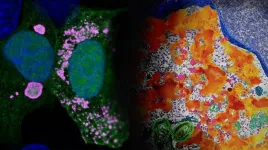(Press-News.org) Philadelphia, August 9, 2023 – Since the beginning of the COVID-19 pandemic caused by the SARS-CoV-2 virus, researchers have been trying to determine why this virus creates such negative long-term effects compared with most coronaviruses. Now, a multi-institutional consortium of researchers led by a team at Children’s Hospital of Philadelphia (CHOP) and the COVID-19 International Research Team (COV-IRT) has found that the genes of the mitochondria, the energy producers of our cells, can be negatively impacted by the virus, leading to dysfunction in multiple organs beyond the lungs. These findings, published online today by the journal Science Translational Medicine, suggest new approaches for treating COVID-19.
Mitochondria are found in every cell in our bodies. The genes responsible for generating mitochondria are dispersed across both the nuclear DNA located in the nucleus of our cells and the mitochondrial DNA (mtDNA) located within each mitochondrion. Prior studies have shown that SARS-CoV-2 proteins can bind to mitochondrial proteins in host cells, potentially leading to mitochondrial dysfunction.
To understand how SARS-CoV-2 impacts mitochondria, researchers from the Center for Mitochondrial and Epigenomic Medicine (CMEM) at CHOP along with their COV-IRT colleagues wanted to analyze mitochondrial gene expression to detect differences caused by the virus. To do this, they analyzed a combination of nasopharyngeal and autopsy tissues from affected patients and animal models.
“The tissue samples from human patients allowed us to look at how mitochondrial gene expression was affected at the onset and end of disease progression, while animal models allowed us to fill in the blanks and look at the progression of gene expression differences over time,” said the study’s first author Joseph Guarnieri, PhD, a postdoctoral research fellow with the CMEM at CHOP.
The study found that in autopsy tissue, mitochondrial gene expression had recovered in the lungs, but mitochondrial function remained suppressed in the heart as well as the kidneys and liver. When studying animal models and measuring the time when the viral load was at its peak in the lungs, mitochondrial gene expression was suppressed in the cerebellum even though no SARS-CoV-2 was observed in the brain. Additional animal models revealed that during the mid-phase of SARS-CoV-2 infection, mitochondrial function in the lungs was beginning to recover.
Taken together, these results reveal that host cells respond to initial infection in a way that involves the lungs, but over time, mitochondrial function in the lungs is restored, while in other organs, particularly the heart, mitochondrial function remains impaired.
“This study provides us with strong evidence that we need to stop looking at COVID-19 as strictly an upper respiratory disease and start viewing it as a systemic disorder that impacts multiple organs,” said co-senior author Douglas C. Wallace, PhD, director of the CMEM at CHOP. “The continued dysfunction we observed in organs other than the lungs suggests that mitochondrial dysfunction could be causing long-term damage to the internal organs of these patients.”
While future studies using this data will study how systemic immune and inflammatory responses may be responsible for more severe disease in some patients, the research team did find a potential therapeutic target in microRNA 2392 (miR-2392), which was shown to regulate mitochondrial function in human tissue samples used in this study.
“This microRNA was upregulated in the blood of patients infected by SARS-CoV-2, which is not something we normally would expect to see,” said co-senior author Afshin Beheshti, PhD, a biostatistician, a visiting researcher at The Broad Institute, and founder and President of COV-IRT. “Neutralizing this microRNA might be able to impede the replication of the virus, providing an additional therapeutic option for patients who are at risk for more serious complications related to the disease.”
Earlier this year, The Gates Foundation provided funding to Dr. Wallace and CMEM for research into how mtDNA variation among world populations might affect mitochondrial function and thus individual sensitivity to SARS-CoV-2. According to Wallace, the demonstration that SARS-CoV-2 markedly affects mitochondrial function supports the hypothesis that individual differences in mitochondrial function could be a factor in individual severity of COVID-19.
This work was also supported by the Division of Intramural Research, NIAID, NIH and, in part, by the Bill & Melinda Gates Foundation grant INV-046722.
Guarnieri et al, “Core mitochondrial genes are down-regulated during SARS-CoV-2 infection of rodent and human hosts.” Sci Transl Med. Online August 9, 2023. DOI: 10.1126/scitranslmed.abq1533.
About Children’s Hospital of Philadelphia: A non-profit, charitable organization, Children’s Hospital of Philadelphia was founded in 1855 as the nation’s first pediatric hospital. Through its long-standing commitment to providing exceptional patient care, training new generations of pediatric healthcare professionals, and pioneering major research initiatives, the 595-bed hospital has fostered many discoveries that have benefited children worldwide. Its pediatric research program is among the largest in the country. The institution has a well-established history of providing advanced pediatric care close to home through its CHOP Care Network, which includes more than 50 primary care practices, specialty care and surgical centers, urgent care centers, and community hospital alliances throughout Pennsylvania and New Jersey, as well as an inpatient hospital with a dedicated pediatric emergency department in King of Prussia. In addition, its unique family-centered care and public service programs have brought Children’s Hospital of Philadelphia recognition as a leading advocate for children and adolescents. For more information, visit https://www.chop.edu.
END
Researchers find COVID-19 causes mitochondrial dysfunction in heart and other organs
While mitochondrial function recovered in the lungs, function did not recover in the heart and other organs, leading to long-term damage and a possible explanation for detrimental effects of “long COVID”
2023-08-09
ELSE PRESS RELEASES FROM THIS DATE:
Mars: new evidence of an environment conducive to the emergence of life
2023-08-09
The surface of Mars, unlike the Earth's, is not constantly renewed by plate tectonics. This has resulted in the preservation of huge areas of terrain remarkable for their abundance in fossil rivers and lakes dating back billions of years. Since 2012, NASA's Curiosity, the first rover to ever explore such ancient remains, had already detected the presence of simple organic molecules which can be formed by geological as well as biological processes.
However, the emergence of primitive life forms, as hypothesised by scientists, initially requires environmental conditions favourable to the spontaneous organisation ...
Carpets retain a stubborn grip on pollutants from tobacco smoke
2023-08-09
– By Christina Nunez
In rooms where smoking has taken place regularly, tobacco's imprint lingers on indoor surfaces, even long after regular smoking has stopped. The leftover residues, known as thirdhand smoke, can be a long-term source of indoor pollutants. New research from a team led by the Department of Energy's Lawrence Berkeley National Laboratory (Berkeley Lab) zeroes in on carpets as an especially potent – and difficult to clean – reservoir of tobacco contaminants.
When thirdhand smoke settles into surfaces, it doesn't ...
Telecommunications cable used to track sea ice extent in the Arctic
2023-08-09
A telecommunications fiber optic cable deployed offshore of Oliktok Point, Alaska recorded ambient seismic noise that can be used to finely track the formation and retreat of sea ice in the area, researchers report in The Seismic Record.
Andres Felipe Peña Castro of the University of New Mexico and colleagues used distributed acoustic sensing, or DAS, to identify seismic signals related to the motion of waves on open water and the sea ice that suppresses that wave action. The technique offers a way to track sea ice with increasing spatial and temporal resolution—on the scale of hours and kilometers--compared to satellite images that are updated ...
Playing catch-up on weekends may not improve cardiovascular cost of sleep loss
2023-08-09
UNIVERSITY PARK, Pa. — Whether it’s work or play that prevents us from getting enough shut-eye during the week, assuming we can make up for it by sleeping in over the weekend is a mistake. New research led by Penn State reveals that cardiovascular health measures, including heart rate and blood pressure, worsen over the course of the week when sleep is restricted to five hours per night, and attempting to catch up on sleep over the weekend is insufficient to return these measures to normal.
“Only 65% of adults in the U.S. regularly sleep the recommended seven hours per night, ...
A new look inside Ebola's 'viral factories'
2023-08-09
LA JOLLA, CA—New research in the journal Nature Communications gives scientists an important window into how Ebola virus replicates inside host cells. The study, led by scientists at La Jolla Institute for Immunology (LJI), reveals the inner workings of "viral factories," clusters of viral proteins and genomes that form in host cells.
The research team, which included experts from Scripps Research and UC San Diego School of Medicine, found that Ebola virus's replication machinery forms fascinating microscopic ...
Exercise apps a good prescription to boost healthcare workers' mental health
2023-08-09
Simple home workouts using exercise apps can effectively reduce depressive symptoms in healthcare workers and could be a major tool to combat the global mental health crisis in the sector, says new University of British Columbia research.
The study, published today in JAMA Psychiatry, divided participants into either a waitlisted control group or an exercise group who were given free access to a suite of home exercise apps called DownDog, that included yoga, cardio and strength training. They were asked to aim for at least 80 minutes of moderate-intensity ...
Then vs. now: Did the Horn of Africa reach a drought tipping point 11,700 years ago?
2023-08-09
New research suggests that the Horn of Africa is likely to become even drier, not wetter in the future as predicted by most climate models.
‘Wet gets wetter, dry gets drier’. That mantra has been used for decennia to predict how global warming will affect the hydrological cycle in different world regions. But if climate models predict that much of tropical Africa will enjoy a future with wetter weather, then why does it keep getting drier in certain parts of the African tropics, like the Horn of Africa? An international team of researchers ...
Resilient biomedical scientists’ careers took a hit during pandemic
2023-08-09
First study to measure resilience in biomedical scientists during the pandemic
Sixty-one percent of study participants said they experienced a setback during pandemic
‘You can be as resilient as you want, but certain structural factors can hinder your professional advancement’
CHICAGO --- When COVID-19 presented the world with the greatest health challenge in modern history, it was biomedical scientists who stepped up to develop diagnostic testing and vaccines to slow the spread of the disease.
But how did these in-demand scientists fare psychologically and in their careers amid pandemic pressures such as juggling ...
Engineered probiotic developed to treat multiple sclerosis
2023-08-09
Brigham researchers are working on a new approach to target autoimmunity in the brain leverages designer bacteria to make treatment safer and more effective
Researchers from Brigham and Women’s Hospital, a founding member of the Mass General Brigham healthcare system, have designed a probiotic to suppress autoimmunity in the brain, which occurs when the immune system attacks the cells of the central nervous system. Autoimmunity in the brain is at the core of several diseases, including multiple sclerosis. In a new study, researchers demonstrated the treatment’s potential using preclinical models of these diseases, finding that the technique offered a more precise ...
There and back again: how neurons make room for growth in a developing organ
2023-08-09
To function properly, organs require a precise number of cells and a functional architecture, which are established during embryogenesis. Embryos are proficient multitaskers; they grow, and acquire shape and functional architecture all at once. Despite a lot of research on embryo development, scientists do not yetfully grasp how embryos orchestrate all these different tasks in space and time to ensure the formation of healthy organs. This was ...
LAST 30 PRESS RELEASES:
iPS cells from dish to freezer and back
Deep neural networks enable accurate pricing of American options under stochastic volatility
Collective risk resonance in Chinese stock sectors uncovered through higher-order network analysis
Does CPU impact systemic risk contributions of Chinese sectors? Evidence from mixed frequency methods with asymmetric tail long memory
General intelligence framework to predict virus adaptation based on a genome language model
Antibiotic resistance is ancient, ecological, and deeply connected to human activity, new review shows
Vapes, pouches, heated tobacco, shisha, cigarettes: nicotine in all forms is toxic to the heart and blood vessels
From powder to planet: University of Modena engineers forge a low-carbon future for advanced metal manufacturing
Super strain-resistant superconductors
Pre-school health programme does not improve children’s diet or physical activity, prompting call for policy changes, study finds
Autumn clock change linked to reduction in certain health conditions
AI images of doctors can exaggerate and reinforce existing stereotypes
Where medicine meets melody – how lullabies help babies and parents in intensive care
We may never be able to tell if AI becomes conscious, argues philosopher
AI video translation shows promise but humans still hold the edge
Deep ocean earthquakes drive Southern Ocean’s massive phytoplankton blooms, study finds
Without campus leftovers to pick through, the beaks of this bird changed shape during the pandemic
High-dose antibiotic does not reduce mortality in tuberculous meningitis
How many insects fly in the sky above the USA?
Could cheese protect your brain health?
Who faces more difficulty recovering from stroke?
Colliding galaxies create the brightest, fastest growing black holes at their center
New BrainHealth research reveals tradeoffs on sleep with cannabis use for chronic pain
Aging-US now on ResearchGate, enhancing visibility for authors and readers
'Molecular glue' stabilizes protein that inhibits development of non-small cell lung cancer
Mount Sinai Health System is recognized in 2025 Chime Digital Health Most Wired survey
From prey to predator: How carnivores spread beneficial fungi
Menopause symptoms may be frequent and have negative effects, according to female endurance athletes
US Congressmembers’ responses on X to mass shooting events differ along party lines
KAIST-UEL team develops “origami” airless wheel to explore lunar caves
[Press-News.org] Researchers find COVID-19 causes mitochondrial dysfunction in heart and other organsWhile mitochondrial function recovered in the lungs, function did not recover in the heart and other organs, leading to long-term damage and a possible explanation for detrimental effects of “long COVID”




